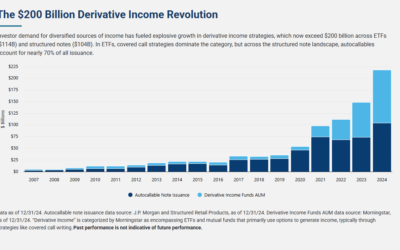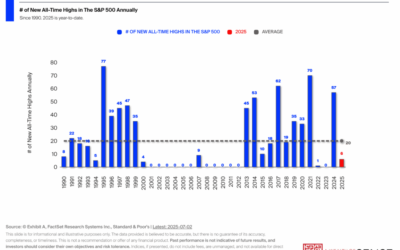Making more without working more. It’s the holy grail of personal finance. But is it as difficult to achieve as it seems? Or are there actual ways to increase your earnings without needing to increase your effort?
The truth is somewhere in between. Yes, it’s possible to increase your income without increasing your effort, but only if you change your strategy. This is the premise of my upcoming book, The Wealth Ladder, which comes out in 2 weeks. The core idea: the strategy that got you to one point in your financial life may not get you to the next.
This is true whether you’re trying to build wealth or simply earn more. Too often we get stuck in the same routines while expecting different results. But, when it comes to making more without working more, the answer isn’t necessarily to work harder, but to work differently.
Below are four strategies I explore in more depth in the book that can help raise your income over time. Let’s dig in.
Negotiate a Raise
The simplest way to get paid more without working more is to ask for a raise. Of course, negotiating a raise is easier said than done. Not only can the situation be stressful, but if you ask for a raise too early or too often, it could harm your reputation with your employer.
Trust me, there’s nothing wrong with asking for a raise. This is particularly true if you’ve gone above and beyond in your role or taken on additional responsibilities.
However, you should prepare for that discussion. Rehearse it. Ask a trusted friend to help if needed. Go through various scenarios and how you might respond. I’ve made the mistake of not preparing for such conversations and it showed.
The good news is, if you ask for a raise, you will probably get it. As the Federal Reserve noted:
Most people who asked for a raise received one. Among those who asked for a raise in 2022, 70 percent also said that they received a raise. This share was similar in 2021 and was up 4 percentage points from 2019, before the pandemic.
LendingTree did a separate study and found that “82% of full-time workers who asked for a pay raise in the past year received one.” And this is among all workers who asked for a raise. I bet if we subset to those who thoroughly prepared beforehand, the success rate would be even higher than 70%-80%.
Ultimately, the higher pay you could receive from a raise should more than make up for the time you spend preparing for a negotiation. While asking for a raise won’t always go in your favor, it’s one of the few times in your career where a little can go a long way.
Get a Higher Paying Job
If asking for a raise in your current role doesn’t yield higher income, you may need to change things up. This could mean finding a new job (i.e. job hopping), learning a new skill, or getting an advanced education. While none of these are guaranteed to increase your pay, many of them can.
Job hoppers in particular can expect anywhere from a 10%-20% pay bump when getting a similar role at a new company. As Experian highlighted:
In pre-pandemic 2019 and 2020, you could score around a 10% pay increase by changing jobs, according to a 2023 Bank of America report. Then, as the “Great Resignation” tightened the labor market and put workers in high demand starting in 2021, companies paid a premium; job-switching could mean around 20% higher pay. But by April 2023, this bump shrank to 13%—partly due to job seekers having less bargaining power in the loosening labor market, but also likely due to wages rising from inflation.
While compensation changes will vary based on industry and labor market conditions, the data suggests that job hopping usually results in higher pay.
The same is true for those that get more education (on average). As the Bureau of Labor Statistics illustrated, those with more education tend to have higher earnings and are less likely to be unemployed:
Of course, correlation is not causation. If I magically gave someone a law degree, that wouldn’t make them a good lawyer. But, if you’re able to successfully obtain such an education, then you will probably earn more than those who don’t.
Regardless of which path you take to finding a higher paying job, it will require some work upfront. I’ve had friends take 6 months (or more) on the job market trying to find the right role. Others attended coding bootcamps or spent years of their life getting a professional degree. These all required work that they were not compensated for (at least right away).
Unfortunately, if you want a higher paying job, this is work that you’ll have to do. There are no shortcuts. While getting a higher paying job will allow you to make more without working more in the future, that doesn’t mean you don’t have to put in the work now to make it happen.
Invest in Income-Producing Assets
So far, everything we’ve looked at to earn more without working more has involved increasing your earnings per hour worked. However, this is only one way to earn income. Another is to invest in income-producing assets that don’t require your time at all. While not all income-producing assets are “set it and forget it”, there are many that require little to no time and can increase your earnings all the same. Income-producing assets include:
- Stocks
- Bonds
- Real Estate
- Farmland
- Businesses
- Royalties
And more. These are all assets that can pay you without requiring much input from you.
The one negative of investing in income-producing assets is that you need to have assets to invest in the first place. Unfortunately, if you just started on your investment journey, your portfolio won’t be generating all that much income. It’s only after you have saved (and invested) a good amount of money that you’ll see tangible results.
How much is a “good amount of money”? What are “tangible results”? They’re up to you. If we assume that a diversified portfolio can, on average, generate 4% per year after inflation, then we can back out how big your portfolio needs to be to support a given income goal. To do this, we can simply take our annual income goal and divided by 4% (or multiply by 25) to get the required portfolio size:
Required Portfolio Size = Annual Income Goal * 25
So if $10,000 (before taxes) is the amount you want to make off your assets each year, then you would need to invest $250,000 [$10,000 * 25]. If you wanted $100,000 a year, you would need $2.5M. And so forth.
Whatever amount you decide on, if you want to earn more without working more, income-producing assets are a great way to go.
Use Leverage to Sell a Product or Service
The last way to make more without working more is to use leverage to sell a product or service. When I say leverage, I’m referring to Naval Ravikant’s definition of leverage, which is how much output you get for each unit of input. In financial terms, it’s how much money you make for each action you take. Those with more leverage earn more than those with less leverage (all else equal).
The four types of leverage are: labor, capital, content, and code. I won’t review all of them here, but each of them has a way of increasing your earnings without requiring more work on your end in the future.
But to get to that future you will likely need to put in a lot of work now building that leverage. For example:
- You could hire people to build a business [labor]
- You could use your (or someone else’s) money to invest in an asset [capital]
- You could produce valuable entertainment or educational resources [content]
- You could build useful software [code]
Regardless of which type of leverage you choose, they all require work to create. However, once that work has been put in, you can earn much more per hour as a result. I know this from experience.
Back in 2020, I calculated that my average hourly wage from all of my writing activities (i.e. total earnings divided by hours spent) was $12 an hour (before taxes). Not a ton of money for all the work I had put in. But, if I were to re-do this same calculation today, it would be over $100 an hour. All of those earlier hours I spent writing helped increase how much I make per hour today.
It’s possible that at some point in the future my average hourly wage from writing ends up being over $200 or $500 or even $1,000 per hour. I don’t know. But I do know that this was only possible because I built leverage (via content) to make it happen.
The Bottom Line
When it comes to making more without working more, you basically have two options:
- Earn more for each hour you work.
- Divorce your time from your earnings.
Getting a raise or a higher paying job can increase how much you earn per hour, but the real way to supercharge your income is to earn independently of your time. That’s what income-producing assets and leverage can do.
The good news is that anyone can divorce their time from their earnings. The bad news is that it takes a ton of upfront work to get there. After all, making more without working more is easy after you’ve already put in the work.
With that being said, happy earning and thank you for reading!
If you liked this post, consider signing up for my newsletter.
This is post 458. Any code I have related to this post can be found here with the same numbering: https://github.com/nmaggiulli/of-dollars-and-data







0 Comments